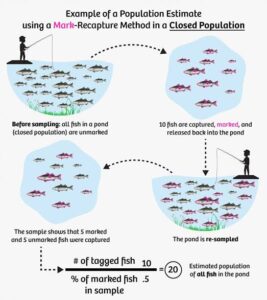Back to: ZOOLOGY 500 Level
Welcome to class!
Good day, champion! I’m happy to see you ready to learn something very important in wildlife research today. The topic we’re covering is mark-recapture methods—a clever way ecologists use to estimate the number of animals in a population without having to catch every single one. This method is especially useful in studying animals that are shy or hard to find in places like Nigerian forests, savannahs, or wetlands. Let’s break it down simply so you can understand and apply it easily.
Mark-Recapture Methods
What is the Mark-Recapture Method?
Imagine you want to know how many frogs live in a pond near your village, but it’s impossible to count all of them because they move around and hide. Mark-recapture is a way to estimate the population by capturing some animals, marking them safely, and then releasing them back. Later, you capture animals again and see how many you catch are already marked. Using this information, you can calculate an estimate of the total population.

How Does It Work?
Capture a number of animals from the population (let’s call this number M) and mark them in a way that won’t harm or confuse them. For example, small harmless paint dots or tags.
Release the marked animals back into their habitat and wait enough time for them to mix with the unmarked population.
Capture another sample of animals (number C) from the population.
Count how many in this second group are marked (number R).
You can then estimate the total population (N) using the formula:
N = (M × C) / R
Why Is Mark-Recapture Useful?
It’s especially helpful when:
Animals are mobile and hard to count directly.
You want to study animal populations without harming or disturbing them too much.
You need estimates to help conserve endangered species or manage wildlife sustainably.
Important Considerations
Marks must not harm or change animal behaviour.
Enough time should be given for marked animals to mix well with the population.

The population should be relatively closed (no big changes due to births, deaths, immigration, or emigration during the study).
Example from Nigeria
A student at the University of Lagos used mark-recapture to estimate the population of mud turtles in a swamp near the Lekki area. She safely tagged 30 turtles, released them, and after a few days, caught 40 turtles, of which 10 were tagged. Using the formula, she estimated the population as (30 × 40) / 10 = 120 turtles in the swamp.
Summary
- Mark-recapture helps estimate animal population size without counting every individual.
- It involves capturing, marking, releasing, and recapturing animals.
- The method relies on careful marking and timing for accurate estimates.
- It supports wildlife conservation and management efforts.
Evaluation
- Explain in your own words how the mark-recapture method works.
- Why is it important that marked animals mix well with the population before recapture?
- What could happen if marks harm the animals?
- Using the formula, calculate the population if 50 animals were marked, 60 were recaptured, and 15 were marked in the recaptured group.
Well done for sticking with this important lesson! You’re growing into a smart ecologist who respects and cares for wildlife. Afrilearn is proud of your progress and excited for the next steps in your learning journey. Keep your passion alive—you’re doing great!
